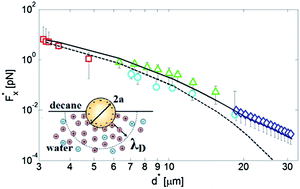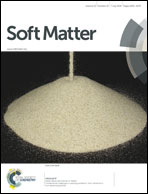The influence of particle size and residual charge on electrostatic interactions between charged colloidal particles at an oil–water interface
Abstract
Electrostatic repulsive interaction forces between charged spherical colloidal particles at an oil–water interface are numerically studied by solving the standard three-dimensional Poisson–Nernst–Planck model. We directly compute the electrostatic force on a finite-size spherical particle and our results are applicable to all inter-particle distances without distinguishing short ranges and long ranges. The model successfully captures the scaling relationship of the force and the separation distance (d) between two charged particles at both short ranges (exponential dependence) and long ranges (∼d−4). The model also bridges these two ranges and provides quantitative information in the middle range. In addition, by assuming that there is a small residual electric charge at the particle–oil interface, the standard model is capable of quantitatively predicting the repulsive particle–particle interaction force over a large range of the separation distance between two particles. The favorable agreement between experiments and theoretical predictions also leads one to conclude that the standard model adequately describes the particle–particle interactions trapped at the oil–water interface.


 Please wait while we load your content...
Please wait while we load your content...